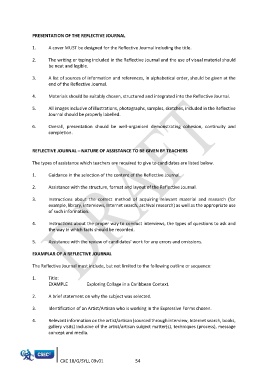Page 1455 - SUBSEC October 2017_Neat
P. 1455
PRESENTATION OF THE REFLECTIVE JOURNAL
1. A cover MUST be designed for the Reflective Journal including the title.
2. The writing or typing included in the Reflective Journal and the use of visual material should
be neat and legible.
3. A list of sources of information and references, in alphabetical order, should be given at the
end of the Reflective Journal.
4. Materials should be suitably chosen, structured and integrated into the Reflective Journal.
5. All images inclusive of illustrations, photographs, samples, sketches, included in the Reflective
Journal should be properly labelled.
6. Overall, presentation should be well-organised demonstrating cohesion, continuity and
completion.
REFLECTIVE JOURNAL – NATURE OF ASSISTANCE TO BE GIVEN BY TEACHERS
The types of assistance which teachers are required to give to candidates are listed below.
1. Guidance in the selection of the content of the Reflective Journal.
2. Assistance with the structure, format and layout of the Reflective Journal.
3. Instructions about the correct method of acquiring relevant material and research (for
example, library, interviews, Internet search, archival research) as well as the appropriate use
of such information.
4. Instructions about the proper way to conduct interviews, the types of questions to ask and
the way in which facts should be recorded.
5. Assistance with the review of candidates' work for any errors and omissions.
EXAMPLAR OF A REFLECTIVE JOURNAL
The Reflective Journal must include, but not limited to the following outline or sequence:
1. Title:
EXAMPLE Exploring Collage in a Caribbean Context.
2. A brief statement on why the subject was selected.
3. Identification of an Artist/Artisan who is working in the Expressive Forms chosen.
4. Relevant information on the artist/artisan (sourced through interview, Internet search, books,
gallery visits) inclusive of the artist/artisan subject matter(s), techniques (process), message
concept and media.
CXC 18/G/SYLL 09v01 54

